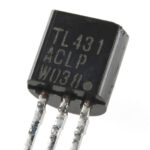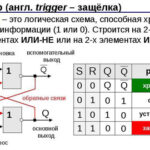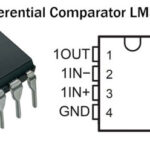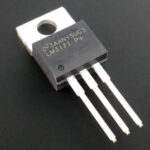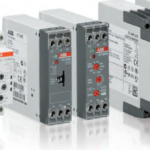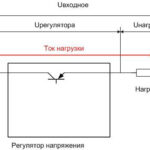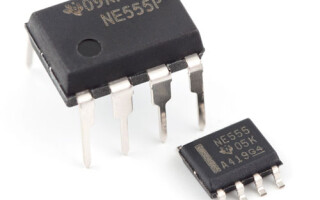When developing electronic devices, it often becomes necessary to generate pulses of a given length or to generate a rectangular signal with a given frequency and a certain ratio of length to pause. It will not be difficult for an experienced designer to design such a device on separate digital elements, but it is more convenient to use a specialized microcircuit for this purpose.
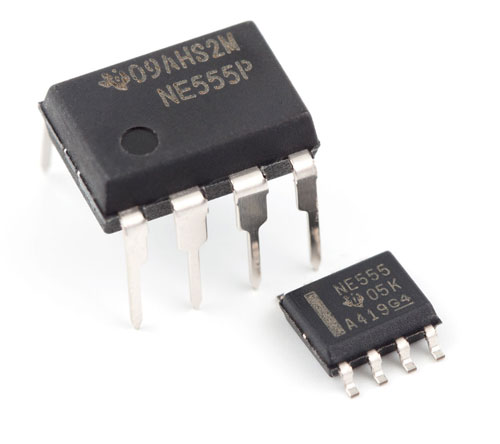
Content
What is the NE555 chip and where can it be used
The NE555 chip was developed in the 70s of the last century and is still very popular among professionals and amateurs. It is a timer enclosed in a housing with 8 pins.Available in DIP or various surface mount (SMD) versions.
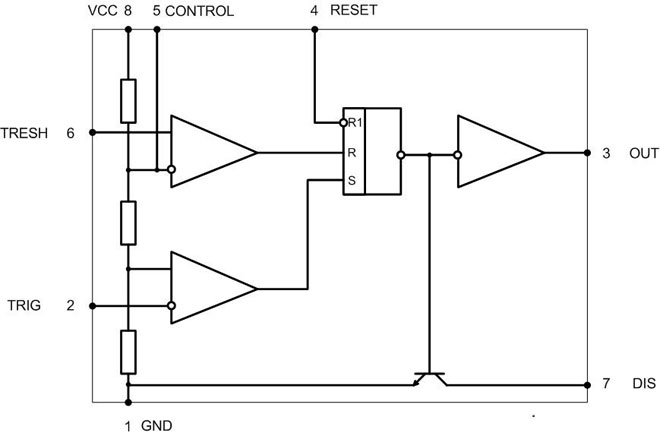
The microcircuit contains two comparators - upper and lower. At their inputs, a reference voltage is formed, equal to 2/3 and 1/3 of the supply voltage. The divider is formed by resistors resistance 5 kOhm. The comparators control the RS flip-flop. A buffer amplifier and a transistor switch are connected to its output. Each comparator has one free input, it serves to supply external control signals. The upper comparator is triggered when a high level appears and switches the output of the microcircuit to a low level. The lower “guard” lowers the voltage below 1/3 VCC and sets the timer output to a logical unit.
The main characteristics of the NE555 chip
The characteristics of the timer from different manufacturers may differ within small limits, but no one has fundamental deviations (except for microcircuits of unknown origin, you can expect anything from them):
- The supply voltage is standardly indicated from +5 to +15 V, although the datasheets contain limits of 4.5 ... 18 V.
- The output current is 200 mA.
- The output voltage is a maximum of VCC minus 1.6 V, but not less than 2 V with a supply voltage of 5 V.
- Current consumption at 5 V is not more than 5 mA, at 15 V - up to 13 mA.
- The error in the formation of the pulse duration is no more than 2.25%.
- The maximum operating frequency is 500 kHz.
All parameters are specified for an ambient temperature of +25 °С.
Location and purpose of pins
The timer outputs are arranged as standard, regardless of the case design - in ascending order from the key counterclockwise (when viewed from above), from 1 to 8. Each output has its own purpose:
- GND – common power supply wire of the device.
- TRIG - when a low level is applied, it starts the second (lower according to the scheme) comparator, a logical unit appears at its output, setting the internal RS flip-flop to 0. An external timing RC circuit is connected to it. Takes precedence over THR.
- OUT - exit. The high level of the signal is slightly lower than the supply voltage, the low level is 0.25 V.
- RESET - reset. Regardless of the signals on other inputs, if there is a low level, it resets the output to 0 and disables the timer.
- CTRL - management. It always has a level 2/3 of the power rail voltage. Here you can apply an external signal and modulate the output with it.
- THR - when a high level appears (more than 2/3 of the supply), the first (upper according to the scheme) trigger is set to 1 and the internal RS flip-flop goes into the state of a logical unit.
- DIS - the discharge of the time-setting capacitor. When a high-level trigger appears at the output, the internal transistor opens, a fast discharge occurs. The timer is ready for the next cycle of operation.
- VCC – power outlet. It can be supplied with voltage from 5 to 15 V.
Description of the operating modes of the NE555 chip
Although the architecture of the timer allows it to be used in a variety of modes, there are three typical modes of operation for the NE555.
Single vibrator (standby multivibrator)
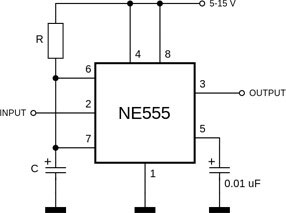
Starting position:
- input 2 high logic level;
- at the inputs R and S of the trigger - zeros;
- trigger output - 1;
- the discharge circuit transistor is open, the capacitor C is shunted;
- output 3 is level 0.
When a zero level appears at input 2, the lower comparator switches to 1, flipping the trigger to 0. A high level appears at the output of the microcircuit.At the same time, the transistor closes, ceasing to shunt the capacitor. It starts charging through resistor R. As soon as the voltage across it reaches 2/3 of VCC, the upper comparator will work, set the trigger back to 1, and the timer output to 0. The transistor will turn on and discharge the capacitance. Thus, a positive pulse will be formed at the output, the beginning of which is determined by an external signal at input 2, and the completion depends on the time of the capacitor charge, which is calculated by the formula t=1.1⋅R⋅C.
multivibrator
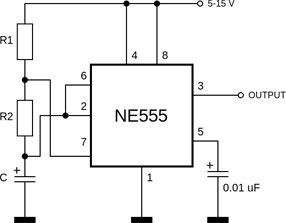
When power is applied, the capacitor is discharged, at input 2 (and 6) logic 0, at the output of timer 1 (this process is described in the previous section). After charging the capacitance through R1 and R2 to the level of 2/3 VCC, a high level at input 6 will flip output 3 to zero, and the discharge transistor will turn on. But the capacitor will not be discharged directly, but through R2. As a result, the circuit will come to its original position, and the cycle will repeat again and again. From the description of the process, it can be seen that the charge time is determined by the sum of the resistances R1, R2 and the capacitance of the capacitor, and the discharge time is set by R1 and C. Instead of R1 and R2, you can put variable resistors and quickly control the frequency and duty cycle of the pulses. Formulas for calculation:
- pulse duration t1=0.693⋅(R1+R2)⋅C;
- pause duration t2=0.693⋅R2⋅C;
- pulse repetition rate f=1/(0.693(R1+2⋅R2)⋅C.
The pause time cannot exceed the pulse time. To get around this limitation, the discharge and charge circuits are separated by including a diode in the circuit (cathode to pin 6, anode to pin 7).
Schmitt trigger
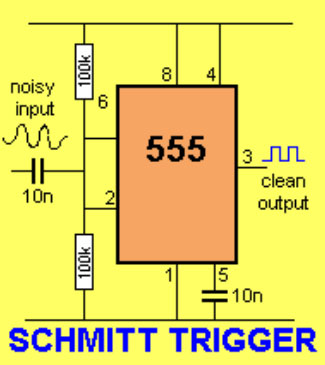
On the 555 chip, you can build a Schmitt trigger.This device converts a slowly changing signal (sinusoid, sawtooth, etc.) into a square wave. Here, timing circuits are not used, the signal is fed to inputs 2 and 6, interconnected. When the threshold of 2/3 VCC is reached, the output voltage abruptly switches to 1, when it drops to the level of 1/3, it also abruptly decreases to zero. The zone of ambiguity is 1/3 of the supply voltage.
Advantages and disadvantages
The main advantage of the NE555 chip is its ease of use - to build a circuit, a small binding is sufficient, which lends itself well to calculation. At the same time, the cost of the device is low.
The main disadvantage of the timer is the pronounced dependence of the pulse duration on the supply voltage. This is due to the fact that the capacitor in the single vibrator or multivibrator circuit is charged through a resistor (or through two), and the upper terminal of the resistor is connected to the supply bus. The current through the resistance is formed by the voltage VCC - the higher it is, the greater the current, the faster the capacitor will charge, the earlier the comparator will work, the shorter the generated time interval will be. For some unknown reason, this moment is not in the technical documentation, but it is well known to the developers.
Another drawback of the timer is that the threshold voltages of the comparators are formed by internal dividers and cannot be adjusted. This limits the application possibilities of NE555.
And one more unpleasant feature. In connection with the push-pull scheme for constructing the output stage, at the moment of switching (when the upper transistor is already open, and the lower one is not yet closed, or vice versa) there is a through current pulse. Its duration is short, but it leads to additional heating of the microcircuit and generates interference in the power circuits.
What are the analogues
During the existence of the timer, a large number of clones have been developed and released. They are produced by various companies, but they all contain the number 555 in the name. Among the factories producing analogues, there are both popular manufacturers of electronic components and unknown manufacturers from Southeast Asia. If the former provide the declared parameters, then no guarantees should be expected from the latter. Deviations from the declared characteristics can be large.
In the USSR, a similar timer KR1006VI1 was developed. Its functionality is exactly the same as the original, with one exception: its output 2 takes precedence over output 6 (and not vice versa, like NE555). This must be taken into account when designing schemes. And one more thing: the КР index means that the microcircuit is produced only in the DIP8 package.
Examples of practical use
The scope of practical application of the timer is wide; within the framework of this review, it will not be possible to fully cover the topic. But the most common examples are worth considering.
In the single vibrator mode on several microcircuits, it is possible to build a code lock with a time limit for dialing the code. Another way is to use it as a signaling device for reaching a threshold level (illuminance, tank filling level, etc.) in conjunction with various sensors.
In the multivibrator mode (astable mode), the timer finds the widest application. On several timers, you can build a garland switch with separate regulation of the flashing frequency, on time and pause time.It is possible to use NE555 as a basis for a time relay and form a consumer switch-on time from 1 to 25 seconds. You can build a metronome for a musician. This is the most used chip mode, and it is impossible to describe all the applications.
As a Schmitt trigger, the timer is used infrequently. But in bistable mode without frequency setting elements, the NE555 is used as a debouncer or a two-button switch in start-stop mode. In fact, only the built-in RS flip-flop is used. It is also known to build a PWM controller based on the timer.
There are collections of circuits that describe various applications of the NE555 timer. They describe thousands of ways to use the chip. But even this may not be enough for the inquisitive mind of the designer, and he will find an additional use of the timer that has not yet been described anywhere. The possibilities laid down by the developers of the microcircuit allow this.
Similar articles:
